10 mins read
Renewable Energy Projects: Navigating Challenges with Professional Software

If you traveled back a decade, building a power plant involved heavy machinery, concrete, steel, and a significant carbon footprint. Today, the situation is a little different. Building a power plant might mean solar panels or wind turbines assembled using sustainable construction materials and carbon-conscious methods. This is primarily due to the ongoing transformation of the construction industry into greener practices.
However, while renewable energy projects are becoming one of the fastest-growing sectors in the construction industry, delivering them is anything but easy. Increasing regulatory changes, tight deadlines, and communication barriers pose significant challenges to even the most experienced companies.
In this blog, we’ll examine renewable energy projects in depth, discuss key statistics and common challenges, and explore how professional construction management software can help alleviate some of these challenges and ensure success.
Renewable Energy Sources List
Renewable energy isn’t a one-size-fits-all effort. From massive wind farms to rooftop solar arrays, these projects vary widely in scale, technology, and complexity. Understanding the different types of renewable energy projects can help highlight the unique challenges and benefits they pose.
Solar: Solar energy is one of the most abundant sources on the planet. In fact, the amount of solar energy from one day can cover the entire energy requirements of the Earth for a year. However, this is a theoretical maximum and not what we can currently obtain; it depends on the time of the day, the region, and the season. Solar projects harness energy from the sun using photovoltaic panels or solar thermal systems. They range from small-scale residential installations to utility-scale solar farms spread across hundreds of acres.
Wind: This type of renewable energy is not a new concept, with the first wind turbines deployed in the US in the 1980s. Wind energy projects capture kinetic energy from wind using turbines whose performance varies depending on placement and can improve in windy conditions. Wind farms can be built onshore or offshore, and they require careful site selection, complex logistics processes, and strict compliance with regulations.
Hydropower: As its name suggests, this energy harnesses the power of moving water. It has been produced for centuries, initially through water wheels, and today, through hydroelectric power stations. These developments involve the movement of large bodies of water contained in large reservoirs or dams, which generate electricity as water flows through them. The projects typically require extensive civil engineering, long planning cycles, and rigorous environmental impact assessments.
Geothermal: This type of energy project harnesses the natural heat from beneath the Earth’s surface and uses it for electricity generation, heating, and cooling. It is considered one of the most reliable renewable energy sources as it does not depend on weather like solar or wind power. These projects typically begin with tests to locate underground reservoirs of hot water or steam, followed by the drilling of deep wells to access the heat. Once the resource is confirmed, a geothermal power plant is built to convert that heat into energy.
Biomass: Biomass energy is produced by burning organic materials, such as wood, agricultural residues, and certain types of waste, that store energy from the sun. It can also be converted into biofuels or biogas through chemical or biological processes. Biomass projects involve constructing industrial facilities where materials can be stored and subsequently burned for energy production. The plants often include boilers, turbines, and emission control systems, and are typically built near material sources to minimize transportation costs and emissions.
Renewable Energy Projects Statistics
Increased awareness about the impact of traditional energy generation has led to the growth of the renewable energy market. According to Straits Research, the renewable energy sector was valued at USD 1085 billion in 2024 and is expected to reach USD 1101.27 billion in 2025, and then USD 2271.2 billion by 2033.
A recent report from GlobalData, titled “Project Insight – Global Power Generation Construction Projects,” reveals that the current global power generation projects pipeline is valued at $7.80 trillion, with 40% of the value coming from wind farm projects, 15% from solar energy projects, and another 15% from hydroelectric power projects. If completed, these projects have the potential to provide a massive amount of renewable energy capacity to the world (1,523 gigawatts, just for solar). The report also highlights a significant global shift toward renewable energy investments, highlighting a growing preference for sustainable sources over traditional fossil fuels.
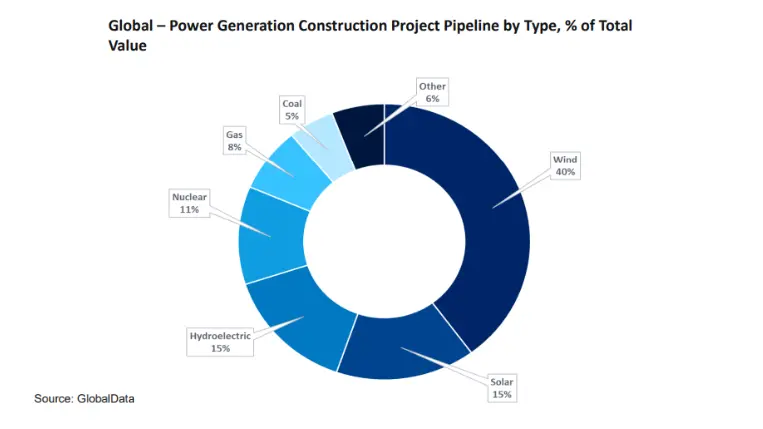
When examining statistics from a regional perspective, the report from GlobalData offers some interesting insights. Western Europe has the highest power generation value at $1.45 trillion, with 72% of projects focusing on wind energy. The Western European region is followed by North East Asia with a pipeline value of $1.12 trillion. However, despite active efforts to transition to cleaner energy sources, most projects from this region still focus on gas, primarily due to China’s high energy demand.
North America is also expected to accelerate its shift toward renewable energy sources. The United States aims for a 100% clean energy economy by 2035 and net-zero emissions by 2050. Significant regulatory changes and investment in renewable energy back this. The International Energy Agency (IEA) reports that investments in clean energy have increased to USD 280 billion in 2023, up from USD 200 billion in 2020. The Infrastructure Investment and Jobs Act (IIJA) and the Inflation Reduction Act (IRA) are also providing funding for renewable energy initiatives.
The Australasia region is also at the top of renewable energy development, with 98% of its project pipeline value being for renewable energy projects (wind, solar, hydroelectric, and Biomass). The report from GlobalData states that Australia has achieved a “record level of investment” of over AUD50 billion. This investment has led to various large-scale initiatives, including AAPoweLink, which aims to export solar power from Australia to Singapore. It involves building a large solar farm and energy storage facility, and is considered one of the top Australian construction projects in recent years.
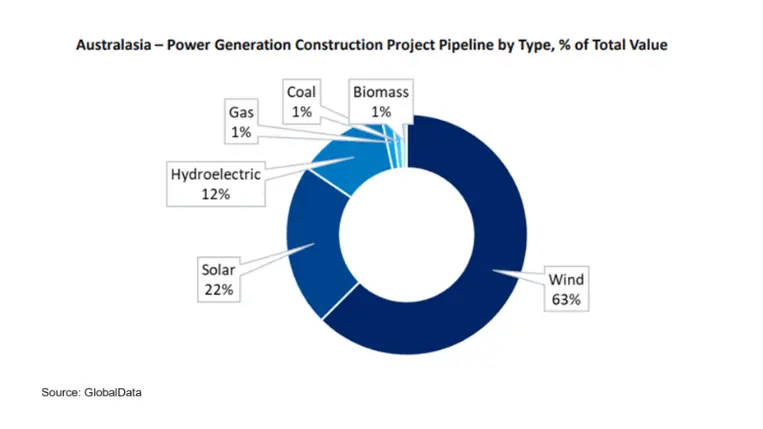
The Australasia region has also been experiencing numerous regulatory changes. For instance, as of February 2025, in Queensland, Australia, wind farm developers are mandated to conduct public consultations, undertake social impact assessments, and develop community benefit agreements. Likewise, the Offshore Renewable Energy Bill in New Zealand aims to establish a comprehensive framework for offshore renewable energy projects, including the requirements for obtaining permits, mandatory consultation with relevant Māori groups, and proof of financial security, among other things.
The Biggest Challenge for Renewable Energy Projects: Sudden Regulatory Changes
As you can see from the statistics discussed above, the renewable energy project sector is growing steadily. However, it is not free of challenges. Some common challenges faced during the process include:
- Selecting the right construction sites with access to transmission lines is a big challenge. The best options for these projects are often far from existing transmission infrastructure, making the project more expensive and complex to secure permits.
- Another challenge is resistance from communities that may oppose the project due to concerns about land use or wildlife impact, which can delay or even cancel it.
- Although renewable energy is a global priority, securing financing for these projects poses a significant challenge due to the uncertainties involved.
- Regardless of their “green” nature, the project’s environmental impact is also a significant challenge, particularly in terms of resource extraction, land use, and the lifecycle of energy systems.
However, while these topics complicate the process, one challenge is even more concerning: sudden changes in regulatory compliance. According to the Renewable Energy Developer report, 86% of renewable energy developers experienced project delays of three months or more due to permit or regulatory issues.
There are many reasons for this. First, the renewable energy sector is still growing and developing, with new technologies emerging constantly that bring new rules and frameworks. In tandem with this, climate change pressures have prompted countries to continually revise their goals and strategies, introducing new legislation to address them. Lastly, renewable energy is also heavily politically driven, with government initiatives coming and going based on shifting political agendas; for example, the removal of tax credits or subsidies that are already factored into project budgets.
On average, a renewable energy project can take around 50 months (4 years) from planning to handover. Considering all the aspects mentioned above, it is common for multiple regulatory changes to occur during that multi-year timeline, mainly since changes can occur at regional, national, or international levels, adding complexity, costs, and delays to already ambitious projects.
To effectively address these regulatory challenges, governments, industry stakeholders, and financial parties must collaborate closely to implement strategies that can help build a more sustainable and energy-efficient future. They should also support themselves with the right technology to keep up with any changes in an organized and productive manner.
How Construction Software Powers Renewable Energy Projects
Staying ahead in the renewable energy sector is not just about using green materials or construction methods; it’s about managing complexity. With continuously shifting regulations and requirements, project developers must effectively coordinate data, people, and processes, all while maintaining compliance across every stage of the project.
This is where purpose-built construction software, like RIB CX, becomes essential. Let’s explore why below!
Single source of truth: RIB CX works as a centralized communication system to store, analyze, and share all relevant project data. This level of integration ensures everyone has access to the latest information in real-time, reducing the risk of errors or omissions. It also helps teams respond to audits, submit accurate documentation on time, and prove that all regulatory requirements have been met.
Risk Mitigation: The live reporting functions of RIB CX enable renewable energy project developers to quickly identify defects, track the status of issues, and analyze their impact on both the schedule and budget. The centralized approach ensures that roles and responsibilities are clearly defined, enabling the rapid and effective resolution of issues.
Document control: The Publication Space module from RIB CX offers an effective document control system, providing a secure space to share files, drawings, contracts, schedules, and more. Information is updated in real-time, preventing common version control issues and ensuring data is available for any regulatory purposes.
Contracts administration: A robust contracts administration module allows teams to manage multiple contracts simultaneously and in real-time. The module offers capabilities for cost estimation, budgeting, cost breakdowns, variation management, and automated payment schedules, ensuring effective contractual control across all project phases.
Quality management: CX also offers a powerful quality control module that contains a library of inspections and test plans with a quality checklist that can be tailored to the project’s requirements. A mobile-based system ensures defects are tracked in real-time and linked to variations, claims, or RFIs. This level of visibility not only helps prevent costly delays but also supports regulatory compliance by ensuring that quality standards are met and that all required documentation and corrective actions are tracked and recorded.
Large Renewable Energy Projects in Australia
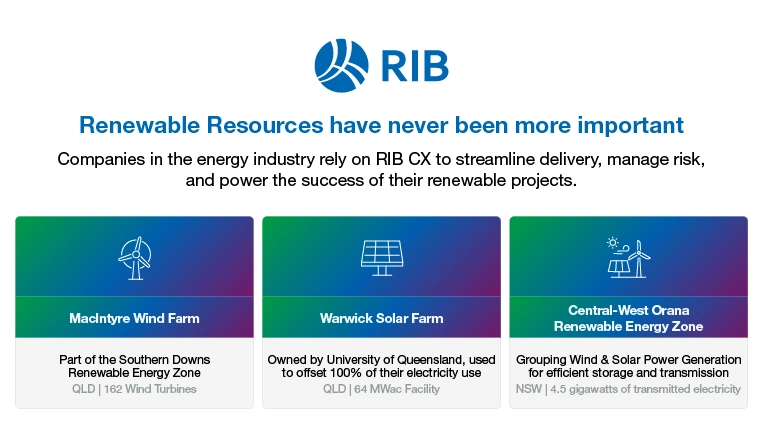
Maclntyre Wind Farm
Developed by ACCIONA Energia and CleanCo, the MacIntyre Wind Farm is expected to become one of the largest onshore wind farms in the southern hemisphere, with 162 turbines across a project area of 32,000 hectares. The farm is part of the larger MacIntyre Wind Precinct, which also includes the Karara Wind Farm (103 MW) and the proposed Herries Range Wind Farm (1,000 MW). These projects collectively aim to generate 2 gigawatts of renewable energy, which will power over 600,000 homes annually. RIB CX has supported the project as a powerful software partner, particularly in managing their quality processes during construction.
Warwick Solar Farm
Owned by the University of Queensland (UQ), the Warwick Solar Farm comprises over 200,000 solar panels, capable of powering more than 25,000 homes annually. The farm, which is supported by over 750 grazing sheep on site, 35,000 native trees, and 8 on-site weather monitoring stations, generates approximately 160,000 megawatt-hours of clean energy. It was built as part of UQ’s efforts to lead the sustainability market, which also includes another solar farm at the Gatton Campus and several other solar systems installed on the rooftops of campuses and buildings. Teams from this project utilized RIB CX to manage contracts, budgets, and forecasts through to final completion, ensuring compliance, profitability, and overall success.
Central-West Orana Renewable Energy Zone
The Central-West Orana Renewable Energy Zone is Australia’s first Renewable Energy Zone (REZ), aiming to unlock approximately 4.5 GW of new network capacity by the late 2020s, with the potential to increase to up to 6 GW by 2038, powering 1.4 million homes once completed. The REZ is designed to integrate several projects in renewable energy, including solar and wind farms, as well as energy storage systems, spanning approximately 20,000 square kilometers in the Dubbo and Dunedoo areas of New South Wales. RIB CX is playing a key role as a powerful tool to support document control and quality processes.
Final Thoughts
From solar and wind to hydropower, geothermal, and biomass, each energy type offers unique advantages and plays a critical role in decarbonizing our planet. As the demand for renewable energy grows, so does the complexity of delivering projects that meet strict regulatory, environmental, and performance standards. From early planning to final handover, clear communication, issue tracking, and documentation are key to staying compliant and on schedule.
Construction management software, such as RIB CX, offers powerful modules for effectively managing contracts, quality, defects, and stakeholder collaboration. Whether you’re building a wind farm, solar array, or hydroelectric plant, CX provides the real-time visibility and audit trails needed to meet regulatory requirements and keep all stakeholders aligned.
If you want to experience all the benefits mentioned above, plus the support of experts with decades of experience in the industry, get your free demo for RIB CX today!
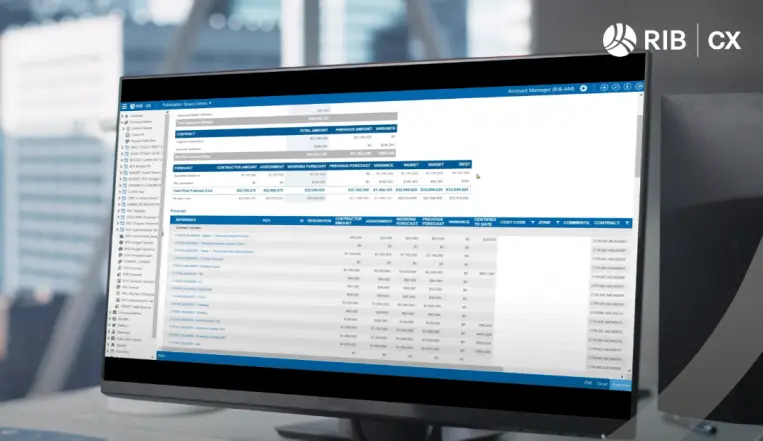
Most Recent
10 mins read
11 mins read
11 mins read
10 mins read
Blog Categories
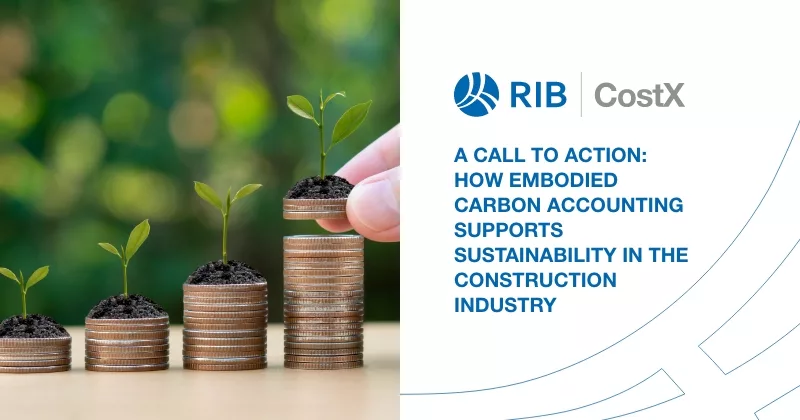
Ebook











